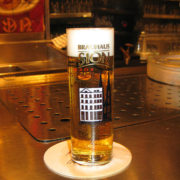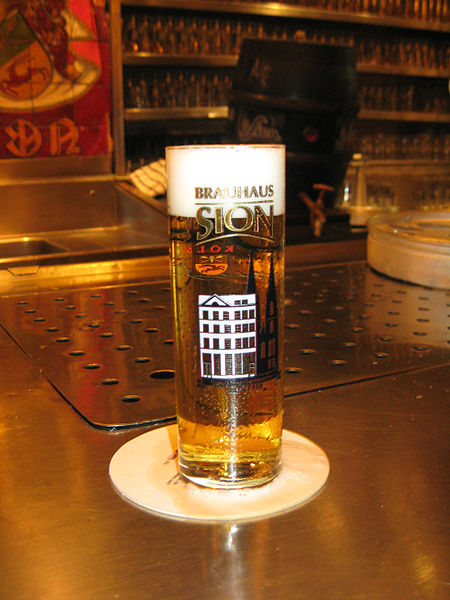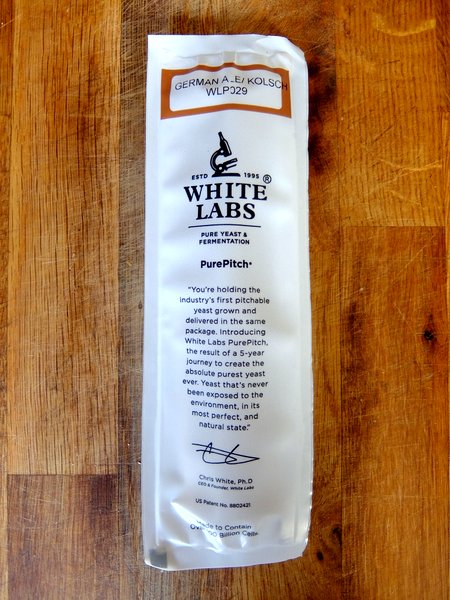Kolsch All Grain Recipe That Goes By The Book
I’m not really doing a Kolsch recipe it’s a “Kolsch-style” recipe!
Kolsch is one of those beer styles it seems that to truly appreciate and understand you have to make a trip to Cologne in Germany.
When you write about it you have to talk about the architecture and the cathedrals in the city. The bars where they serve Kolsch and the waiters that bring the beer to your table in Stange beer glasses.
The trouble is, I have never been to Cologne or even to Germany. Sadly I have only had bottled versions of Kolsch and those examples I have tried are kind of . . . bland?
Fruh Kolsch is the most widely available example and it’s different to differentiate from any bottled Pilsner. This may be the way it’s filtered and pasteurised for bottling. It means though that I only have other peoples romanticized descriptions of Kolsch to go by.
There is only one thing for it then. Brew my own version of Kolsch. edit: Here are the tasting notes.
Kolsch Recipe Quest
As I say, I tried a few bottled examples of Kolsch and they were pleasant. The beer didn’t really match my expectations though. I’d read a fair amount and was expecting more, what I experienced was another type of lager.
I love refreshing, crisp beers and a good lager is a great option. I was expecting something more akin to an English summer ale though.
Here is what the BJCP have to say on the character of Kolsch taken from the BJCP guidelines
Soft, rounded palate comprising of a delicate flavor balance between soft yet attenuated malt, an almost imperceptible fruity sweetness from fermentation, and a medium-low to medium bitterness with a delicate dryness and slight pucker in the finish (but no harsh aftertaste).
The noble hop flavor is variable, and can range from low to moderately high; most are medium-low to medium. One or two examples (Dom being the most prominent) are noticeably malty-sweet up front. Some versions can have a slightly minerally or sulfury water or yeast character that accentuates the dryness and flavor balance. Some versions may have a slight wheat taste, although this is quite rare. Otherwise very clean with no diacetyl or fusels.
A clean, crisp, delicately balanced beer usually with very subtle fruit flavors and aromas. Subdued maltiness throughout leads to a pleasantly refreshing tang in the finish. To the untrained taster easily mistaken for a light lager, a somewhat subtle Pilsner, or perhaps a blonde ale.
Maybe the quote above just proves I’m an untrained taster but I like to think I just haven’t tried the best examples of Kolsch.
A Note On BJCP Guidelines
If you want to research a style of beer you are looking to brew then a great place to start are the BJCP guidelines.
Using this Kolsch recipe as an example I can refer to the guidelines and straight away I know what malt to use, hops, mash schedule, fermentation temperature. As well as colour, ABV, OG, FG and what commercial examples are available should I wish to try those to compare.
If you are designing a recipe based on a style of beer you can’t go wrong by checking out the guidelines.
Kolsch Ingredients
After a little bit of research this is what I have come up with for my version of Kolsch.
Malt Profile: It’s simple and subtle, primarily Pilsner malt with a touch of Vienna and Wheat for the bright white head. There is nothing brash or bold about these malts. We are aiming for smooth, crisp and clean flavours.
Hops: If you are brewing a Kolsch-a-like then you have to choose a German variety. I have gone for a single hop, Hallertauer Mittelfrueh because I like it and I already have some stored in the freezer.
Everything I have read has said that the bitterness is assertive but not overpowering so I have gone to around 24 IBU. I am also going to go quite assertive with the aroma addition at the end of the boil. I am a big fan of Hallertauer and I don’t mind going a little over the guidelines to make a beer a bit more personal to my tastes.
You could of course go completely off style and use whatever hops you like. That is the beauty of home brewing you can brew an American hopped Kolsch or an imperial kolsch it’s completely up to you.
Yeast: I got myself some White Labs WLP029 German Ale / Kolsch yeast. I believe it’s cultured from a brewpub in Cologne and is said to accentuate hop flavours. Most importantly it’s a super clean tasting yeast and gives that crisp, refreshing quality that we are looking for.
I made a starter from the pure pitch sachet the evening before brewday and pitched into the wort at 20°C.
The Kolsch Recipe
Here is the recipe for this Kolsch style attempt. I will follow up shortly with some tasting note and pictures. edit: Here are the tasting notes.
Kolsch - Kölsch
================================================================================
Batch Size: 20 L
Boil Size: 23.335 L
Boil Time: 60.000 min
Efficiency: 70%
OG: 1.047
FG: 1.012
ABV: 4.6%
Bitterness: 23.5 IBUs (Tinseth)
Color: 4 SRM (Morey)
Fermentables
================================================================================
Name Type Amount Mashed Late Yield Color
Pilsner (2 Row) Ger Grain 4.000 kg Yes No 81% 2 L
Vienna Malt Grain 200.000 g Yes No 78% 4 L
Wheat Malt, Ger Grain 100.000 g Yes No 84% 2 L
Total grain: 4.300 kg
Hops
================================================================================
Name Alpha Amount Use Time Form IBU
Hallertau 4.5% 38.000 g Boil 60.000 min Leaf 18.2
Hallertau 4.5% 30.000 g Boil 10.000 min Leaf 5.2
Yeast
================================================================================
Name Type Form Amount Stage
WLP029 - German Ale/Kölsch Yeast Ale Liquid 35.000 mL Primary
Mash
================================================================================
Name Type Amount Temp Target Time
Single Infusion 14.000 L 71.429 C 65.000 C 60.000 min
Final Batch Sparge Infusion 14.000 L 80.666 C 74.000 C 15.000 min






Hey Neil. I have been brewing Kolsch beer for a couple of years now. I have only used Wyeast 2565 but did buy WLP029 and will use it next week. I am wondering about your fermentation temp. I plan on pitching a big starter @ 58 F, letting it rise to 62 F and when it slows down, let it rise again to 68 F. How did your Kolsch taste at 20 C? I have found that my previous Kolsch beers took longer to make than my Pilsners, which is weird.
Cheers,
Chris
Hi Chris, the beer is still in the fermenter. I will get round to bottling in a week or so and post the tasting notes up. I have used WLP029 before though at around 18-20C (64-68) and the results have been good. I didn’t get lots of esters, off flavours or anything like that.
Check out the While Labs site they suggest fermentation between “65-69°F, 18-20°C” and “Does not ferment well less than 62°F, or 16°C, unless during active fermentation”.
If you go too low you may slow down the fermentation and drop the yeast out. I have seen Wyeast 2565 has a much wider fermentation range all the way down to 13°C (56°F) so it could be the two strains are different in that respect. I will post my tasting note up soon and let you know.
Cheers
Neil
I think you get crisper, cleaner, more authentic results from the colder tolerant Wyeast Kolsch yeasts, and ferment as cold as you and the yeasts can manage. Those crisp flavors and delicate balance just don’t appear at higher temps. I read an interview with a German brewer who basically said the same thing, so that’s where I’m getting it from, along with having had Kolsch in Cologne and homebrewed many batches. 10-15 percent wheat adds a lot, and I’m also going to try 3oz of acidulated malt next time. I really like first wort hopping, I grow fresh Mt Hood, that’s been great. Bunch of newer hops to try too..the FWH seems to give extra balance and integration of the flavor. I’m wondering if Mandarina might be too over the top, but, I like to alternate “authentic adherence” with plenty of experimentation.
I got to write an article for the end story in a brew magazine, I wrote an overly complicated, well..dumb recipe for kolsch in retrospect. Simple is better, but I still believe in the first wort hopping, it’s wonderful. My neck hardware has stopped me from brewing for a long time, I’m going to try to get back to it, and my first recipe will be a kolsch!
I grew up in Cologne and have brewed many batches of Kölsch using wyeast 2565. I would say the MOST important step that is easily overlooked is the cold storage in the keg. This beer will probably taste nothing like a Kölsch initially but after 3-4 weeks at fridge temps it will be clean, clear and crisp. Your recipe is spot on although I might just skip the second hops addition.
Great post thanks for giving my home town beer a try
Thanks for the kind words. I love Kolsch and would love to visit the region to try some.